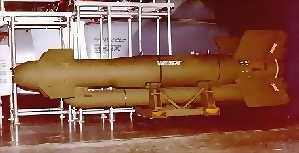

Year: 1984
Type: standoff attack missile
Modifications:
AGM-130A - Mk.84 warhead
AGM-130B - SUU-54 warhead
Service: USA.
Data for AGM-130
Wingspan: 1.5 m
Length: 3.9 m
Diameter: 0.45 m
Launch weight: 1312 kg
Ceiling: 9000 m
Guidance: electro-optical TV or imaging infra-red homing
Warhead: Mk.84 900 kg iron bomb (AGM-130A) or SUU-54 nuclear (AGM-130B)
Year: 1973
Type: fire-and-forget standoff missile
Modifications:
AGM-65A - basic TV-guided missile
AGM-65B - TV-guided with 2x magnification
AGM-65C - experimental passive laser-guided version
AGM-65D - imaging infra-red-guided missile
AGM-65E - passive laser-guided missile
AGM-65F - AGM-65D with larger warhead, naval version with anti-ship attack software
AGM-65G - AGM-65D with larger warhead
Service: USA, various nations in NATO.
Data for AGM-65
Wingspan: 0.72 m
Length (AGM-65A/B/D): 2.5 m
Length (AGM-65C/E/F/G): 2.7 m
Diameter: 0.31 m
Launch weight (AGM-65A/B/D): 210 kg
Launch weight (AGM-65C/E/F/G): 290 kg
Max. speed: 1150 km/h
Maximum range (AGM-65A/B/D): 40 km
Maximum range (AGM-65C/E/F/G): 24 km
Propulsion: TX-481 single stage solid propellant rocket motor with dual thrust
Guidance: closed-circuit TV (AGM-65A/B) or passive laser (AGM-65C/E) or imaging infra-red
(AGM-65D/F/G)
Warhead: contact-fuzed shaped charge high-penetration high-explosive, 56 kg (AGM-65A/B/D),
or blast fragmentation
high-explosive, 136 kg (AGM-65C/E/F/G)
Courtesy Hughes
Boeing AGM-69 SRAM
Year: 1972
Type: Short-Range Attack Missile
Modifications:
Service: USA.
Data for AGM-69
Wingspan: 0.52 m
Length: 4.3 m
Diameter: 0.45 m
Launch weight: 1010 kg
Max. speed: 3985 km/h
Minimum range: 55 km
Maximum range: 200 km
Propulsion: dual impulse single stage solid propellant rocket motor
Guidance: inertial autopilot
Warhead: air burst- or direct action-fuzed W-69 nuclear, 200 kT yield
Year: 1989
Type: all-weather, all-aspect medium-range missile; Advanced Medium Range Air to Air
Missile
Modifications:
Service: USA, Great Britain, Germany.
Data for AIM-120A
Wingspan: 0.63 m
Length: 3.7 m
Diameter: 0.18 m
Launch weight: 152 kg
Max. speed: 4680 km/h (Mach=4.0)
Ceiling: 20000 m
Maximum range: 65 km
Propulsion: ducted solid propellant rocket motor
Guidance: active radar homing
Warhead: proximity- and contact-fuzed high-explosive pre-fragmented, 23 kg
Year: 1974
Type: all-weather long-range missile
Modifications:
AIM-54A - basic missile
AIM-54C - improved guidance, new propulsion system
Service: USA, Iran.
Data for AIM-54C
Wingspan: 0.93 m
Length: 4.0 m
Diameter: 0.38 m
Launch weight: 448 kg
Max. speed: 5700 km/h
Ceiling: 30000 m
Maximum range: 200 km
Propulsion: Rocketdyne Mark 47 solid propellant rocket motor (AIM-54A) or Aerojet Mark 60
solid propellant rocket motor (AIM-54C)
Guidance: active pulse Doppler radar homing
Warhead: proximity- and impact-fuzed annular blast fragmentation or continuous rod, 61 kg
General
Dynamics AIM-7 "Sparrow"

Year: 1956
Type: all-weather medium-range missile
Modifications:
AIM-7F - solid-state electronics
AIM-7M - new seeker
Service: USA, Australia, Great Britain, Taiwan, Iran, Japan, Germany, Israel, Canada,
Spain, Egypt, South Korea, Greece,
Italy.
Data for AIM-7M
Wingspan: 1.0 m
Length: 3.7 m
Diameter: 0.2 m
Launch weight: 228 kg
Max. speed: 2850 km/h
Maximum range: 96 km
Propulsion: solid propellant Aerojet Mk.65 rocket motor
Guidance: semi-active monopulse radar homing
Warhead: proximity- and impact-fuzed high-explosive continuous rod blast fragmentation, 40
kg
Year: 1956
Type: short- to medium-range missile
Modifications:
AIM-9B - first production version
AIM-9C - Motorola semi-active radar homer
AIM-9D - nitrogen-cooled seeker
AIM-9E - AIM-9B with improved seeker, thermoelectric seeker cooling
AIM-9G - uses Sidewinder Expanded Acquisition Mode (SEAM)
AIM-9H - AIM-9G with solid-state electronics
AIM-9J - AIM-9B and AIM-9E with SEAM
AIM-9L - all-aspect capability, improved maneurability
AIM-9M - AIM-9L with improved seeker
AIM-9N - AIM-9J with improved maneurability
AIM-9P - modernized AIM-9E, AIM-9J and AIM-9N, active optical fuze
AIM-9R - improved AIM-9M
AGM-122 "Sidearm" - anti-radar air-to-surface version of AIM-9
Service: USA, North Yemen, Malaysia, Spain, Bahrain, Great Britain, Iran, Turkey, Oman,
Pakistan, Australia, Tunisia, Belgium, Greece, Saudi Arabia, Canada, Kenya, Portugal,
Sweden, Norway, France, South Korea, Switzerland, Philippines, Thailand, Singapore, Japan,
Taiwan, Italy, Malaysia, Jordan, Chile, Netherlands, Egypt, Israel, Kenya.
Data for AIM-9
Wingspan (AIM-9B): 0.56 m
Wingspan (AIM-9L): 0.62 m
Length (AIM-9B): 3.1 m
Length (AIM-9L): 2.8 m
Diameter: 0.13 m
Launch weight (AIM-9B): 72 kg
Launch weight (AIM-9L): 85 kg
Max. speed: 2850 km/h
Maximum range (AIM-9B): 6 km
Maximum range (AIM-9L): 8 km
Propulsion: single stage solid propellant rocket motor
Guidance: passive infra-red homing
Warhead: proximity-fuzed high-explosive continuous rod or annular blast fragmentation, 9
kg
The Sidewinder's first combat use was in October 1958, when Taiwanese in F-86s launched them against Chinese
MiG-17s, claiming as many as 14 shot down in one day. AIM-9s scored most of the air-to-air
kills made by US Navy and Air Force aircraft in the Vietnam War, and by the Israeli Air
Force in the 1967 and 1973 wars in the Middle East. During the 1982 air engagements over
Lebanon's Bekaa Valley, 51 out of the 55 Syrian-flown MiGs shot down were hit by
Sidewinders.
In the 1982 conflict in the Falkland Islands, between Great Britain and Argentina, British
Sea Harrier Vertical
Short-Take- off and Landing (VSTOL) aircraft used AIM-9L Sidewinders for 16 confirmed
kills and 1 probable
against Argentine aircraft (of a total 20 air-to-air kills; another 45 Argentine aircraft
were shot down by surface-to-air missiles in that conflict).
Compared to its dominant role in the 1982 Falkland Islands campaign as well as the Israeli
operation in Lebanon, the Sidewinder was used relatively little during Operation Desert
Storm's air assault against Iraqi targets. The lower use resulted from the nature of most
engagements (a stern chase with little "jinking" by the targets) and
improvements in the longer-range AIM-7 Sparrow AAM that eliminated the need for a
follow-up attack at closer range.
However, Sidewinders fired by US Air Force F-15C Eagle jets downed 6
Iraqi combat aircraft. 2 more Su-22 Fitters were shot down by AIM-9s 3 weeks after the
ceasefire. A Saudi F-15 pilot downed 2 French-built Iraqi Mirage F1s with Sidewinders in a
single attack. 2 F/A-18 Hornets and an F-14 Tomcat scored with AIM-9s, the Hornets
shooting down MiG-21 Fishbeds and the F-14Tomcat downing a
helicopter.
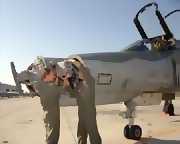
The APG-65 radar is an all-weather multimode sensor that uses
programmable digital processors to provide the features and flexibility needed for both
air-to-air and air-to-surface missions. The key to the APG- 65's flexibility is its
programmable signalprocessor -- a high-speed digital computer that provides the capability
to respond to new threats and to accommodate improved modes and weapons through software
changes rather than hardware retrofit. The built-in test system provides total end-to-end
radar preflight checkout and continuous monitoring.
The APG-65 radar is operational in F/A-18 Hornet strike fighters flown by the U.S. Navy
and Marine Corps and the air forces of Australia, Canada, Kuwait, and Spain. It also has
been adapted to upgrade the German F-4 Phantom aircraft and AV-8B Harrier II Plus aircraft
for the U.S. Marine Corps and the Italian and Spanish navies.
Courtesy Hughes
Martin Marietta (General Electric) M61A1 "Vulcan" cannon
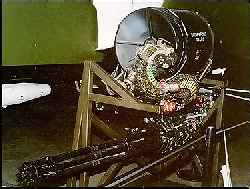
The M61A1 Vulcan cannon is a six-barrel 20mm gun capable of firing 6,600
rounds per minute. Its operation is based upon the principle used in the rapid-firing gun
invented by Richard J.Gatling in the 1860s. The six rotating barrels, firing one at a
time, permit a high rate of fire while at the same time reducing the problem of barrel
wear and heat generation. The gun can be driven electrically, hydraulically, or by a
ram-air turbine. TheVulcan has equipped such USAF aircraft as the F-104, F-105B/D/F, F-15,
F-16, A-7D, F-111A, F-4E, B-58, and B-52H. A ram-air driven M61A1 is the heart of the
SUU-16/A external gun pod that can be carried under the wings of high-performance aircraft
lacking internally mounted guns. The Vulcan is one of the USAF weapons that served in
Operation Desert Storm.
Courtesy Martin Marietta
Pratt & Whitney Fighter Engines
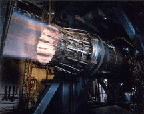 From
Pratt & Whitney's tradition of excellence and "dependable engines" evolved
the F100 family of fighter engines. Since the first F100 entered service in 1974, each
succeeding model has re-established the best fighter engine safety record in the history
of the United States military services.
From
Pratt & Whitney's tradition of excellence and "dependable engines" evolved
the F100 family of fighter engines. Since the first F100 entered service in 1974, each
succeeding model has re-established the best fighter engine safety record in the history
of the United States military services.
More than 6,000 F100s, in the air forces of the United States and 16 other nations, have
now accumulated more than 11 million engine flight hours, all in rugged front-line fighter
conditions.
They have been operated at low altitude, high-speed "ram" conditions, the true
test of a fighter
engine.
The initial model, the F100-PW-100, won an intense U.S. Air Force competition to power the
twin-engine McDonnell Douglas F-15 air superiority fighter. The
PW-100 represented a quantum leap forward in fighter engine technology and could operate
in extreme temperature and pressure environments.
It was followed by the F100-PW-220, the same basic engine, tailored for the installation
in the single-engine Lockheed Martin F-16. In the early 1980s, Pratt
& Whitney and the U.S. Air Force initiated development of the PW-220, featuring an
increased life core section, a digital electronicengine control, a gear-type fuel pump,
augmentor improvements and an engine diagnostics unit.
Since entering service in 1985, the PW-220 has established new standards for safety,
reliability and durability. The U.S. Air Force Thunderbirds' choice of PW-220-powered
F-16s for their flight demonstrations is a tribute to the safety and reliability of the
engine. The PW-220 version of the F100 family of fighter engines powers both F-15s and
F-16s.
The F100-PW-220E ("E" for equivalent) illustrates the company's continuing
dedication to operators of existing engines. The PW-220E is an engine upgrade that gives
earlier F100 models (PW-100 and PW-200) all the performance, reliability, durability and
maintainability features of the PW-220 at a fraction of the price of a new engine.
The F100-PW-229 Increased Performance Engine joined the U.S. Air Force fleet in 1991. It
provides 22
percent greater takeoff thrust and as much as 35 percent more thrust in certain areas of
the flight envelope. It is interchangeable with all previous F100 models. An evolutionary
design based on the PW-220, the PW-229 incorporates an extension of the technology that
gives the PW-220 its outstanding safety and reliability.
Pratt & Whitney is developing an upgraded version of the PW-229, called the
F100-PW-229A, which features a larger and more efficient fan. Designed to provide up to
35,000 pounds of thrust without sacrificing durability, the new model will greatly enhance
durability and lower costs when operated at the current PW-229 thrust rating. An
experimental engine demonstrated 37,154 pounds of thrust in cold weather at the company's
Connecticut
test facilities. This equates to more than 35,000 pounds of thrust at sea level, standard
day conditions. The PW-229A is a candidate for the F-15E and F-16C/D fighters. It is designed to be installed in both aircraft and
could be retrofitted into the current fleet. The PW-229A provides the capability of
tailoring engine performance to meet mission requirements. It is also a candidate for
future international fighter applications.
Through these efforts, and many more, Pratt & Whitney is continuing to set the world's
standards for
fighter engines.
The F100-PW-220 is an increased reliability, improved maintainability
member of the F100 family of fighter engines, which has accumulated more than 11 million
engine flight hours as power plants for F-15s and F-16s. The PW-220 was the first fighter
engine for which the U.S. Air Force approved a 4,000-cycle interval between major hot
section inspections and the first with a digital electronic engine control (DEEC).
Materials capable of withstanding high temperatures and pressures, advanced cooling
techniques, fault isolation capability and the benefits of the DEEC have enabled the
PW-220 to establish new standards for safety, reliability and durability since entering
service in 1985.
Through the end of 1992, the PW-220 had accumulated 757,000 engine flight hours with the
U.S. Air Force and recorded a 60-percent lower shop visit rate than the combined PW-100
and PW-200 models. The newer model required approximately one-half the maintenance
man-hours for each engine flight hour compared to the predecessor models.
Kits are available to upgrade earlier F100 models to the PW-220 configuration.
Special Features
Increased life core
Digital electronic engine control
Gear-type fuel pump
Augmentor improvements
Engine diagnostic unit
Vital Statistics (Average Specification Requirements)
Maximum thrust (full augmentation)
23,770 lb. (105.7 kN)
Intermediate thrust (non-augmented)
14,590 lb. ( 64.9 kN)
Weight
3,234 lb. (1,467 kg)
Length
191.2 in. (4.85 m)
Inlet diameter
34.8 in. (0.88 m)
Maximum diameter
46.5 in. (1.18 m)
Bypass ratio
0.6 to 1
Overall pressure ratio
25 to 1
Milestones
Qualification complete: 1985
Entered operational service: 1985
F-15/F-16 flight test complete: 1986
Courtesy Pratt & Whitney
LANTIRN FLIR
The Low-Altitude Navigation and Targeting Infra Red for Night (LANTIRN)
system gives AirForce strike aircraft an accurate, night, low-altitude, precision bombing
capability. The system consists of two externally-mounted pods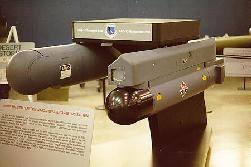
carried on some fighter aircraft. LANTIRN was first employed during the Persian Gulf War.
Development of LANTIRN began in 1980, and the first production pod was delivered in 1987.
The AAQ-13 navigation pod contains a Forward
Looking Infra Red sensor (FLIR) and a Terrain Following Radar (TFR). FLIR imagery provides
the pilot a view of terrain ahead of the aircraft at
night. The TFR allows "hands-off" flight as low as 100 feet above the ground
while avoiding obstacles in the aircraft's path. The AAQ-14 targeting pod has a FLIR and a
laser designator/ranger to "illuminate" or mark the
target for laser-guided bomb deliveries. The USAF ordered LANTIRN pods for F-15E and
selected F-16C/D fighters. The pods on display were received from the Martin Marietta
Corporation in 1994.
Courtesy U.S. Air Force Museum
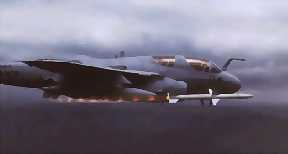 The
AGM-88 HARM (High-speed Anti-Radiation Missile) was designed to destroy enemy radars. Used
by both the USAF and Navy to suppress enemy defenses, the HARM was one of the most
important weapons in the Persian Gulf War.
The
AGM-88 HARM (High-speed Anti-Radiation Missile) was designed to destroy enemy radars. Used
by both the USAF and Navy to suppress enemy defenses, the HARM was one of the most
important weapons in the Persian Gulf War.
The HARM weighs 800 pounds and has a range of more than 40 miles. Its radar seeker covers
a wide range of frequencies and may be quickly reprogrammed to handle new threats. The
HARM has an active laser fuse and uses a 145-pound warhead containing thousands of
tungsten alloy cubes to destroy a target. The AGM-88 was first used against Libya in 1986,
and thousands of HARMs were launched by USAF and Navy fighters during Desert Storm. Over
20,000 HARMs have been ordered since production began in 1981.
McDonnell Douglass AGM-84D Harpoon
Services: Navy, Air Force, and Coast Guard
Description: The AGM-84D Harpoon is an all-weather, over-the-horizon, anti-ship missile
system.
Features:
The Harpoon's active radar guidance, warhead design, and low-level, sea- skimming cruise
trajectory assure high survivability and effectiveness. The missile is capable of being
launched from surface ships, submarines, or (without the booster) from aircraft. The
AGM-84D has been adapted for use on Air Force B-52G bombers, which can carry from eight to
12 of the missiles.
Inventory: Classified
Background: Originally developed for the Navy to serve as its basic anti-ship missile for
fleetwide use, the AGM-84D also has been adapted for use on the Air Force's B-52G bombers.
The AGM-84D was first introduced in 1977, and on the Navy's P-3 Orion aircraft in 1979.
General Characteristics
Primary Function: Air, surface, or submarine launched anti-surface (anti-ship) cruise
missile.
Contractor: McDonnell Douglas
Power Plant: Teledyne Turbojet and solid propellant booster for surface and submarine
launch.
Thrust: 660 pounds (approximately 594 kilograms)
Length: 12 feet, 7 inches (3.79 meters) -- air launched; 15 feet (4.55 meters) -- surface
and submarine launched.
Weight: 1,145 pounds (515.25 kilograms) -- air launched; 1,470 pounds (661.5 kilograms) --
submarine or ship launched
from box or canister launcher.
Diameter: 13.5 inches (34.29 centimeters)
Wing Span: 3 feet (91.44 centimeters) with booster fins and wings.
Range: Over-the-horizon, in excess of 60 nautical miles.
Speed: High Subsonic
Guidance: Sea-skimming cruise monitored by radar altimeter, active radar terminal homing.
Warhead: Penetration high-explosive blast (488 pounds/224 kilograms)
Unit Cost: $720,000
Date Deployed: 1985
The AGM/RGM/UGM-84 "Harpoon" series of missiles are long-range
sea-skimming anti-ship missiles that are widely used by NATO. Harpoons can be launched
from a variety of vessels, including the AGM(air-launched), RGM(surface or ship-launched),
and UGM(submarine- launched) versions. The Harpoon is a "fire-and-forget"
weapon, using both inertial and active-radar guidance.
In June 1971, McDonnell Douglas received a Department of Defense contract for the
development of an air-launched anti-ship missile, with long range as the key design goal.
To achieve this goal, the Harpoon was fitted with a turbojet engine, which doesn't provide
the supersonic capability of rocket motors, but does give a the Harpoon a 75 mile plus
range. All three variants of the AGM-84 entered service together in 1977.
The Harpoon can be fired in two modes. The 'Range and Bearing Launch' mode allows the late
activation of the active radar as a means of reducing the chances of the missile being
detected. The other launch mode is 'Bearing Only Launch', used when an exact location of
the target is unknown. In this mode, the missile is fired on the target's bearing, and the
radar is activated early in the missile's flight. The missile then searches through a 90
degree arc for a target and if none is found, the missile is programmed to self-destruct.
The Harpoon was first used in combat in 1984 against Libyan missile ships in the Gulf of
Sidra in March 1986. At least two Libyan ships were destroyed as a result of this
engagement.
Specifications (AGM-84A):
Manufacturer: McDonnell Douglas Astronautics Company
Weight:
Missile: 1160 lbs.
Warhead: 488 lbs.
Length: 13 ft.
Diameter: 13 inches
Wingspan: 3 ft.
Guidance: Lear-Sigler strapdown inertial and Texas Instruments PR-53/DSQ-58 two-axis
active radar for terminal phase
Propulsion: Teledyne Continental J402-CA-400 turbojet rated at 680 lbs. static thrust
Performance:
Speed: 645 mph
Range: 75 miles+
Warhead: 488 lb. proximty- and impact-fused semi-armor-piercing blast/fragmentation
Standoff Land Attack Missile SLAM and SLAM-ER
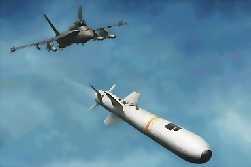
The Standoff Land Attack Missile (SLAM) is a derivative of the AGM-84A Harpoon anti-ship missile designed to engage ships and land
targets. SLAM is launched from carrier-based aircraft.
The SLAM shares common control, warhead, and sustainer sections with the Harpoon, but it
also has a Rockwell-Collins Global Positioning System (GPS) that allows the missile's path
to be updated or corrected after launch. In addition to using Harpoon components, SLAM
adopts the Imaging Infrared (IIR) seeker of the AGM-65 Maverick and the data link of the
AGM-62 Walleye. When the seeker is activated, the pilot/weapons officer receives a video
image of the target and can select an aiming point on the target for a precision strike.
The missile then operates autonomously. The missile can also be controlled from a plane
other than the firing plane, providing the capability to attack targets of opportunity
selected by mid-course observation through the missile's seeker. In tests, the SLAM was
launched from an A-6E and locked on to target by an accompanying A-7 pilot. The same
aircraft combination may have been used during its first operational flights against Iraqi
targets in January 1991, although 2 F/A-18 Hornets have also successfully launched and
guided the SLAM.
Initial Operating Capability (IOC) of the SLAM was in 1990. First operational use on 19
January 1991 as part of Operation Desert Storm.
Specifications:
Manufacturer: Douglas Missile Systems
Weight:
Missile: 1366 lbs.
Warhead: 500 lbs.
Length: 14.6 ft.
Diameter: 13 inches
Wingspan: 3 ft.
Guidance: IIR-guided
Propulsion: Teledyne Continental CAE-J402-CA-400 turbojet sustainer
Performance:
Speed: Mach 0.85
Range: approx. 70 mi+
Warhead: DESTEX blast/fragmentation high-explosive with preselected instantaneous or delay
fusing
SLAM-ER (Expanded Response)
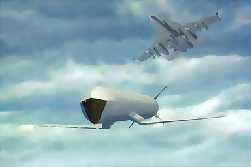
Retrofit program upgrades existing SLAMs for longer range and greater effectiveness.
Courtesy McDonnell Douglas